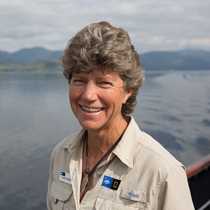Our day started with a pre-breakfast excursion on the shore of Bartlett Cove in the surroundings of the Glacier Bay Visitor Center. Between jogs and casual strolling through the grounds, we had the chance to enjoy the peaceful temperate rainforest, surrounded by the calls of the varied thrush. Near the visitor center is the skeleton of Snow the humpback whale, a whale who had lived in Bartlett Cove for many years. Her skeleton continues to educate visitors to this area, giving us all an appreciation of the size of these great marine mammals.
At Bartlett Cove we picked up park service ranger Valerie Fazan and Alaska Native Voices Cultural Interpreter Kari Ames, both of who stayed with us throughout the day, providing information and interpretation on both nature and native cultures of the area. As we set sail into Glacier Bay, ranger Valerie introduced us to the park, explaining that where is now Glacier Bay, there was once land prior to the Little Ice Age. Grand Pacific Glacier ground out the valley, eventually reaching the ocean where contact with the relatively warm salt water caused the glacier’s retreat. We are now left with the watery bay where once the Tlingit made their home.
Glacier Bay was filled with fog till mid-morning, lifting just in time to give us a view of the shore at Tidal Inlet. There we spotted a brown bear foraging along the intertidal zone for barnacles, crabs, and whatever else it could find. A humpback whale rose up not far away while sea otters floated past. Shortly after Tidal Inlet, we passed Gloomy Knob where several mountain goats lounged on the rocks. It was a wildlife rich morning.
In the afternoon, we reached the far end of Glacier Bay, where we had a stellar view of Margerie Glacier; we were hoping for an ice calving event – and yes! We watched ice fall in large slabs and chucks from the face, with a roar and a splash that is known as “white thunder.” The 200-foot-high wall of ice was a grand sight. The deck crew went ice-fishing at Margerie Glacier and provided a chunk of ice off the glacier that was then used for watercolor painting. Magnificent art!
Headed back down the bay, Kari’s talk on Tlingit culture was interrupted by a wildlife sighting that puzzled the naturalists; two creatures moving around on the rocky shoreline. Young wolverines? Marten? Fisher? Marmots? At a distance it was hard to say. Though still a mystery, the animals were probably hoary marmots.
Recap was highlighted by Junior Rangers who studied Glacier Bay National Park throughout the day and received their honorary badges. Shortly after, we arrived at South Marble Island with its sea lions and puffins. Another rich and diverse day in southeast Alaska.
One of our Global Explorers was inspired to write this poem, a contribution to our trip:
Crabs, crabs
In the sea
On the bottom
On the top.
Crabs.







